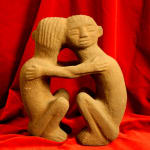Basalt Sculpture Of Siamese Twins, 100 CE - 1000 CE
Basalt
13
PF.3059
Further images
Initially thought to have represented an embracing couple, this very rare sculpture depicts a pair of squatting conjoined twins that are attached at the head. The representation is slightly stylised,...
Initially thought to have represented an embracing couple, this very rare sculpture depicts a pair of squatting conjoined twins that are attached at the head. The representation is slightly stylised, with slim bodies, slender limbs and careful detailing to the hair and fingers. The faces are traditionally rendered, with coffee-bean eyes, triangular noses and nugatory mouths. They surface of the stone is smoothed with age, but their lack of patination implies that they have been exposed to the elements for some period of time.
Conjoined or “Siamese” twins are statistically rare, but do appear in almost all cultures to a greater or lesser extent. They are either viewed as a curse – in which case they are killed or left to die in the open – or are revered as magical. The fact that the sculptor has invested so much time in making this impressive piece would suggest the latter. Medically, the head is the second most common place to be conjoined, although prevalence of any conjoined twinning is less than 1/100,000 live births for the world at large.
Large basalt sculptures such as this were public pieces, and were usually objects of reverence for societies at least the size of villages. This is an impressive and interesting piece of ancient Mesoamerican sculpture.
Conjoined or “Siamese” twins are statistically rare, but do appear in almost all cultures to a greater or lesser extent. They are either viewed as a curse – in which case they are killed or left to die in the open – or are revered as magical. The fact that the sculptor has invested so much time in making this impressive piece would suggest the latter. Medically, the head is the second most common place to be conjoined, although prevalence of any conjoined twinning is less than 1/100,000 live births for the world at large.
Large basalt sculptures such as this were public pieces, and were usually objects of reverence for societies at least the size of villages. This is an impressive and interesting piece of ancient Mesoamerican sculpture.





